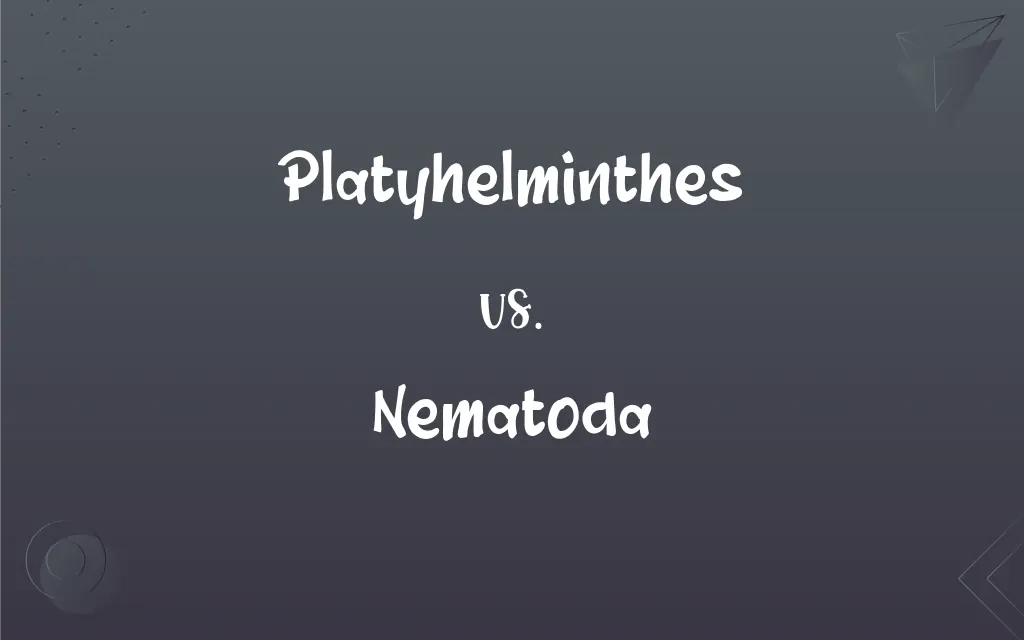Platyhelminthes vs. Nematoda: What's the Difference?
Edited by Aimie Carlson || By Harlon Moss || Updated on October 29, 2023
Platyhelminthes are flatworms, lacking body cavity, with bilateral symmetry, while nematoda are roundworms, having a pseudocoelom, with a complete digestive system.

Key Differences
Platyhelminthes, commonly known as flatworms, are invertebrates characterized by their flat, symmetrical bodies and lack of a true body cavity (coelom). On the other hand, nematoda, commonly referred to as roundworms, are also invertebrates but have a tube-like, cylindrical body shape with a pseudocoelom, providing them with a body cavity.
Platyhelminthes are mainly found in marine, freshwater, and moist terrestrial environments. In contrast, nematoda are ubiquitous, being found in a variety of habitats ranging from terrestrial to aquatic environments. Some nematodes are parasitic, affecting both animals and plants.
The platyhelminthes have a simple nervous system and excretory system, lacking a circulatory system and respiratory organs. In contrast, nematoda possess a more developed nervous system, and a complete digestive system, with a mouth and an anus.
Comparison Chart
Flat body shape
Cylindrical body shape
Body Shape
Lack of coelom
Pseudocoelom
Body Cavity
ADVERTISEMENT
Mostly parasitic
Can be parasitic or free-living
Lifestyle
Simple nervous system
Developed nervous system
Nervous System
Platyhelminthes and Nematoda Definitions
Platyhelminthes
Platyhelminthes exhibit bilateral symmetry.
When you look at a platyhelminth, you can draw a line down the middle and have two symmetrical halves.
Nematoda
Nemotoda are a phylum of invertebrate roundworms.
Ascaris is a common nematoda that can infect humans.
Platyhelminthes
Platyhelminthes can be parasitic or free-living.
Tapeworms, which are parasitic platyhelminthes, infect the intestines of their host.
ADVERTISEMENT
Nematoda
Nemotoda have a pseudocoelom, a false body cavity.
The pseudocoelom in nemotoda acts as a hydrostatic skeleton.
Platyhelminthes
Platyhelminthes lack a true body cavity or coelom.
The lack of a coelom in platyhelminthes means that their bodies are flat.
Nematoda
Nemotoda can be parasitic or free-living.
Some nemotoda, like hookworms, are parasitic and infect the intestines of their host.
Platyhelminthes
Platyhelminthes have a simple nervous system.
Despite their simple nervous system, platyhelminthes can exhibit complex behaviors.
Nematoda
Nemotoda exhibit bilateral symmetry.
Like platyhelminthes, nemotoda are symmetrical along their longitudinal axis.
Platyhelminthes
Platyhelminthes are a phylum of invertebrate flatworms.
Planarians are a type of platyhelminthes.
Nematoda
Nemotoda have a complete digestive system.
The digestive system of nemotoda includes a mouth and an anus.
Platyhelminthes
Flatworms
FAQs
Where are nematoda found?
Nemotoda are found in a variety of habitats, from terrestrial to aquatic environments.
How do nematoda reproduce?
Nemotoda typically reproduce sexually.
Do nemotoda have a circulatory system?
Nemotoda also lack a circulatory system.
Do platyhelminthes have a nervous system?
Platyhelminthes have a simple nervous system.
Are platyhelminthes symmetrical?
Yes, platyhelminthes exhibit bilateral symmetry.
What is nematoda?
Nemotoda are a phylum of invertebrate roundworms.
What is the digestive system of platyhelminthes like?
Platyhelminthes have a simple digestive system.
Where are platyhelminthes found?
Platyhelminthes are found in marine, freshwater, and moist terrestrial environments.
What type of body cavity do platyhelminthes have?
Platyhelminthes lack a true body cavity or coelom.
Do nematoda have a nervous system?
Nemotoda have a developed nervous system.
What is the lifestyle of nemotoda?
Nemotoda can be parasitic or free-living.
What is the digestive system of nematoda like?
Nemotoda have a complete digestive system, with a mouth and an anus.
Can nematoda be parasitic?
Yes, some nemotoda are parasitic.
Do platyhelminthes have a circulatory system?
Platyhelminthes lack a circulatory system.
What is platyhelminthes?
Platyhelminthes are a phylum of invertebrate flatworms.
What type of body cavity do nematoda have?
Nemotoda have a pseudocoelom, a false body cavity.
Can platyhelminthes be parasitic?
Yes, some platyhelminthes are parasitic.
What is the lifestyle of platyhelminthes?
Platyhelminthes can be parasitic or free-living.
Are nemotoda symmetrical?
Yes, nemotoda exhibit bilateral symmetry.
About Author
Written by
Harlon MossHarlon is a seasoned quality moderator and accomplished content writer for Difference Wiki. An alumnus of the prestigious University of California, he earned his degree in Computer Science. Leveraging his academic background, Harlon brings a meticulous and informed perspective to his work, ensuring content accuracy and excellence.
Edited by
Aimie CarlsonAimie Carlson, holding a master's degree in English literature, is a fervent English language enthusiast. She lends her writing talents to Difference Wiki, a prominent website that specializes in comparisons, offering readers insightful analyses that both captivate and inform.































































